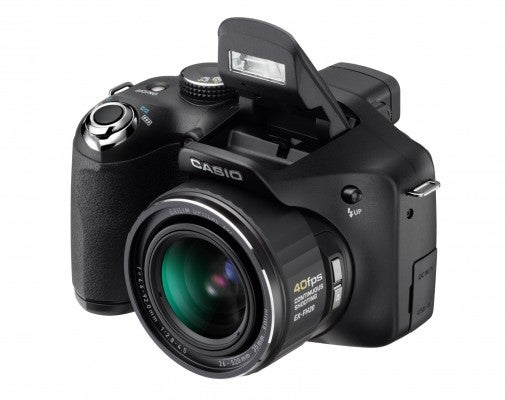The High Speed Casio EXILIM Pro EX FH20 is all about speed. 40fps continuous shooting for stills and up to 1000fps video capture, all tied in with a 20x optical zoom makes this one beast of a high speed superzoom. But is it any good, or a mere gimmick? The What Digital Camera Casio EX-FH20 review…
Casio EXILIM Pro EX-FH20 Review
Design & Performance
Casio EXILIM Pro EX-FH20 review – Design & Performance
The EXILIM Pro EX-FH20, as with so many bridge cameras, isn’t small or light. Not least because it has to house a large lens to make its 20x optical zoom possible. That’s a whopping wide-angle stretching from 26mm through to 520mm. The EXFH-20’s body, however, fits rather snugly around the lens and – at least assuming you’re right handed – fits to the hand using the grip well. The flash is manually controlled on the top of the camera, so your fingers wont get in the way of your shot. The wide/tele toggle at the front right is well placed too, making for easy use that feels intuitive at all times.
The Casio EX-FH20 places its various high speed modes on a thumbwheel on top of the camera, which is easy to navigate. Scene modes – Casio’s ‘Best Shot’ offers a wide variety – take a back seat, accessed via a ‘BS’ (seriously!) button on the back of the camera. This is less immediate than the high speed modes on the thumbwheel, though remain relatively easy to access and are always available when needed.
 As the EXILIM FH20 isn’t a DSLR there’s no mirror – which it what makes it possible for such high frame rate shooting. It also means that the viewfinder is electronic (EVF), showing an electronic version of what would otherwise be seen on the LCD screen (as selected via the EVF/LCD button on the back of the camera). Electronic viewfinders are less pleasing to the eye, but, to the EX-FH20’s benefit, can be useful in bright sunlight when it becomes too tricky to see the screen. Most compacts fail to feature an electronic viewfinder of any kind, so whilst its inclusion is welcome – and indeed where the ‘bridge camera’ term is derived from – it does fall-down compared to truly high-end EVFs. However, the 230K dot LCD screen performs relatively well, even in bright light, and has a decent viewing angle when tilting the camera.
As the EXILIM FH20 isn’t a DSLR there’s no mirror – which it what makes it possible for such high frame rate shooting. It also means that the viewfinder is electronic (EVF), showing an electronic version of what would otherwise be seen on the LCD screen (as selected via the EVF/LCD button on the back of the camera). Electronic viewfinders are less pleasing to the eye, but, to the EX-FH20’s benefit, can be useful in bright sunlight when it becomes too tricky to see the screen. Most compacts fail to feature an electronic viewfinder of any kind, so whilst its inclusion is welcome – and indeed where the ‘bridge camera’ term is derived from – it does fall-down compared to truly high-end EVFs. However, the 230K dot LCD screen performs relatively well, even in bright light, and has a decent viewing angle when tilting the camera.
The buttons on the back of the EX-FH20 are largely without symbols, given that all menus appear on the screen. This means that even in the dark you can easily change your settings and know exactly what you’re shooting with. The controls are, overall, pretty decent too and, whilst they’re never going to have the rapid speed of control that a DSLR would offer, make clear and simple sense. The main digital menu to the right of the screen can be vertically scrolled through, with additional options displaying horizontal electronic sliders to adjust settings, as controlled via the rear d-pad. Simple, effective stuff.
In performance terms, the Casio EX-FH20 is good for the most part. The lens is a little slow to focus on occasion, but consistent throughout the range and feels sturdy. Finding focus at the superzoom level can be tricky, especially without the ability to manual focus. It is possible to manually move your AF point via the menu, but this is slow and wont be particularly useful for grabbing the action shot. There are additional controls on offer, such as quick-reference AEL (exposure lock) and macro to the left side of the lens. This is particularly effective when using the viewfinder, without taking your eye away. However, AF is what the EX-FH20 relies on, so those looking for greater control may want to look towards the DSLR end (or pseudo-DSLR) of the market, as something like a Panasonic G1 is about the same size and weight.
As for the macro mode, this too is strong, offering a close-to-lens functionality at the wide end and a more than reasonable shortest distance at various telephoto ranges.
Recording video with the EX-FH20 does have some rather serious limitations however. For relatively fixed subjects you’ll find shooting is great, but where subjects move the lack of both manual and autofocus means there’s considerable liklihood that your subject will fall out of focus. Upping the aperture to try and accommodate can only make so much difference, plus previewing video exposure isn’t possible either. Additionally, video modes that record in frame rates beyond 210fps introduce what is essentially a crop factor. So if you set up shot ready to record, when you push the shutter you will effectively remove your framing. This doesn’t effect the standard HD 720p recording.
The Casio EXILIM Pro EX-FH20 also comes equipped with image stabilisation – different options help stabilise against handshake or subject movement, depending on your preference. With such a long zoom available (520mm) it’s much needed, as keeping a shot steady when hand held at this zoom range is, as with any product, tricky indeed.






